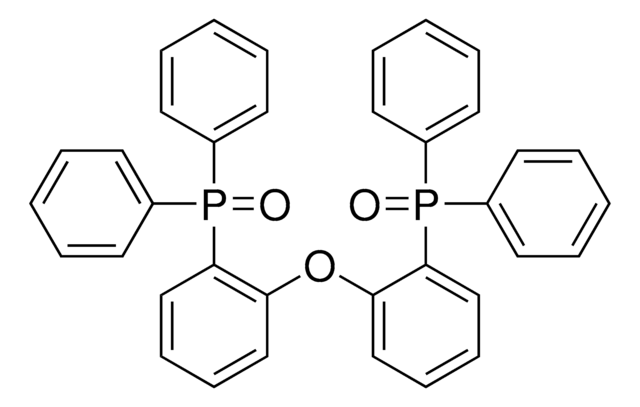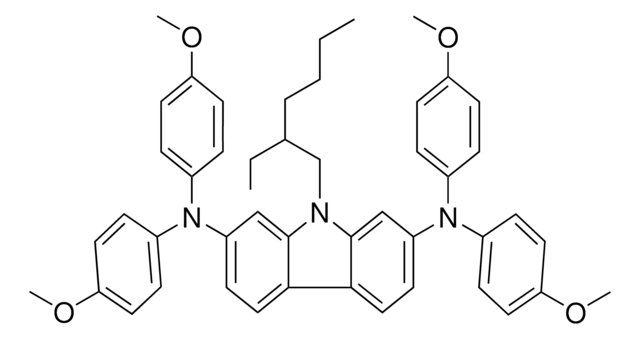おすすめの製品
product name
PO-T2T, >=99% (HPLC),
グレード
sublimed grade (>99% (HPLC))
詳細
PL-295, 379 nm (in CH2Cl2)
形状
solid
分子量
Mw 909.8 g/mol
色
white
λmax
272 nm in dichloromethane
軌道エネルギー
HOMO -6.8 eV
LUMO -2.8 eV
保管温度
15-25°C
アプリケーション
Device configuration:
ITO/MoO3 (3 nm)/ TAPC (35 nm)/CBP:TTM-3NCz (3.0 wt%; (40 nm) and CBP:TTM3PCz (3.0 wt%; 25 nm)/B3PYMPM (10 nm)/PO-T2T (70 nm)/LiF (0.8 nm)/Al (100 nm).
The first Tandem, All-exciplex-based WOLED was constructed using PO-T2T for a device structure configured by two parallel blend layers of mCP/PO-T2T and DTAF/PO-T2T, generating blue and yellow exciplex emission, respectively. The resulting device demonstrates for the first time a tandem, all-exciplex-based white-light OLED (WOLED) with excellent efficiencies ηext: 11.6%, ηc: 27.7 cd/A, and ηp: 15.8 ml/W with CIE(0.29, 0.35) and CRI 70.6 that are nearly independent of EL intensity. The tandem architecture and blend-layer donor/acceptor (1:1) configuration are two key elements that fully utilize the exciplex delay fluorescence, providing a paragon for the use of low-cost, abundant organic compounds en route to commercial WOLEDs.
ITO/MoO3 (3 nm)/ TAPC (35 nm)/CBP:TTM-3NCz (3.0 wt%; (40 nm) and CBP:TTM3PCz (3.0 wt%; 25 nm)/B3PYMPM (10 nm)/PO-T2T (70 nm)/LiF (0.8 nm)/Al (100 nm).
The first Tandem, All-exciplex-based WOLED was constructed using PO-T2T for a device structure configured by two parallel blend layers of mCP/PO-T2T and DTAF/PO-T2T, generating blue and yellow exciplex emission, respectively. The resulting device demonstrates for the first time a tandem, all-exciplex-based white-light OLED (WOLED) with excellent efficiencies ηext: 11.6%, ηc: 27.7 cd/A, and ηp: 15.8 ml/W with CIE(0.29, 0.35) and CRI 70.6 that are nearly independent of EL intensity. The tandem architecture and blend-layer donor/acceptor (1:1) configuration are two key elements that fully utilize the exciplex delay fluorescence, providing a paragon for the use of low-cost, abundant organic compounds en route to commercial WOLEDs.
PO-T2T is an electron transport/hole blocking material in OLED, or an electron acceptor material in organic electronics.
An efficient action of radical-based OLEDs, whose emission originates from a spin doublet, rather than a singlet or triplet exciton was demonstrated in a study published in Nature.
While the emission process is still spin-allowed in these OLEDs, the efficiency limitations imposed by triplet excitons are circumvented for doublets. Using a luminescent radical emitter, an OLED with maximum external quantum efficiency of 27% at a wavelength of 710nm-the highest reported value for deep-red and infrared LEDs was achieved. In this very efficient OLEDs, selective hole injection into the HOMO and electron injection to the SOMO was achieved imploying TAPC as the hole transport layer, and PO-T2T as the electron transport layer to form the fluorescent doublet excited state with near-unity internal quantum efficiency.
An efficient action of radical-based OLEDs, whose emission originates from a spin doublet, rather than a singlet or triplet exciton was demonstrated in a study published in Nature.
While the emission process is still spin-allowed in these OLEDs, the efficiency limitations imposed by triplet excitons are circumvented for doublets. Using a luminescent radical emitter, an OLED with maximum external quantum efficiency of 27% at a wavelength of 710nm-the highest reported value for deep-red and infrared LEDs was achieved. In this very efficient OLEDs, selective hole injection into the HOMO and electron injection to the SOMO was achieved imploying TAPC as the hole transport layer, and PO-T2T as the electron transport layer to form the fluorescent doublet excited state with near-unity internal quantum efficiency.
保管分類コード
13 - Non Combustible Solids
WGK
WGK 3
引火点(°F)
Not applicable
引火点(℃)
Not applicable
適用法令
試験研究用途を考慮した関連法令を主に挙げております。化学物質以外については、一部の情報のみ提供しています。 製品を安全かつ合法的に使用することは、使用者の義務です。最新情報により修正される場合があります。WEBの反映には時間を要することがあるため、適宜SDSをご参照ください。
Jan Code
907073-VAR:
907073-250MG:
907073-BULK:
最新バージョンのいずれかを選択してください:
Tzu-Chieh Lin et al.
Nature communications, 9(1), 3111-3111 (2018-08-08)
The lack of structural information impeded the access of efficient luminescence for the exciplex type thermally activated delayed fluorescence (TADF). We report here the pump-probe Step-Scan Fourier transform infrared spectra of exciplex composed of a carbazole-based electron donor (CN-Cz2) and
Piotr Pander et al.
ACS applied materials & interfaces, 10(34), 28796-28802 (2018-07-26)
The photophysics of an exciplex state formed between a small molecule and a polymer is investigated in this work. The results obtained with this blend show the strong potential of polymer-small-molecule blends for triplet harvesting in organic light-emitting diodes (OLEDs)
Wen-Yi Hung et al.
Scientific reports, 4, 5161-5161 (2014-06-05)
Exploiting our recently developed bilayer interface methodology, together with a new wide energy-gap, low LUMO acceptor (A) and the designated donor (D) layers, we succeeded in fabricating an exciplex-based organic light-emitting diode (OLED) systematically tuned from blue to red. Further
Xin Ai et al.
Nature, 563(7732), 536-540 (2018-11-23)
Organic light-emitting diodes (OLEDs)1-5, quantum-dot-based LEDs6-10, perovskite-based LEDs11-13 and micro-LEDs14,15 have been championed to fabricate lightweight and flexible units for next-generation displays and active lighting. Although there are already some high-end commercial products based on OLEDs, costs must decrease whilst maintaining high
Yi-Tzu Hung et al.
ACS applied materials & interfaces, 10(40), 34435-34442 (2018-09-18)
Two new nonconjugated linked dicarbazole materials, dCzPSi and dCzPSO2, with high triplet energy were synthesized and characterized. dCzPSi and dCzPSO2 were adopted as unipolar host materials for the green thermally activated delayed fluorescence (TADF) emitter (4CzIPN) to achieve high-efficiency organic
資料
Professor Tokito and Professor Takeda share their new materials, device architecture design principles, and performance optimization protocols for printed and solution-processed, low-cost, highly flexible, organic electronic devices.
ライフサイエンス、有機合成、材料科学、クロマトグラフィー、分析など、あらゆる分野の研究に経験のあるメンバーがおります。.
製品に関するお問い合わせはこちら(テクニカルサービス)


![ポリ[ビス(4-フェニル)(2,4,6-トリメチルフェニル)アミン] a poly(triaryl amine) semiconductor](/deepweb/assets/sigmaaldrich/product/structures/122/933/c34a34ab-284f-4890-adb8-126247a91d9b/640/c34a34ab-284f-4890-adb8-126247a91d9b.png)





